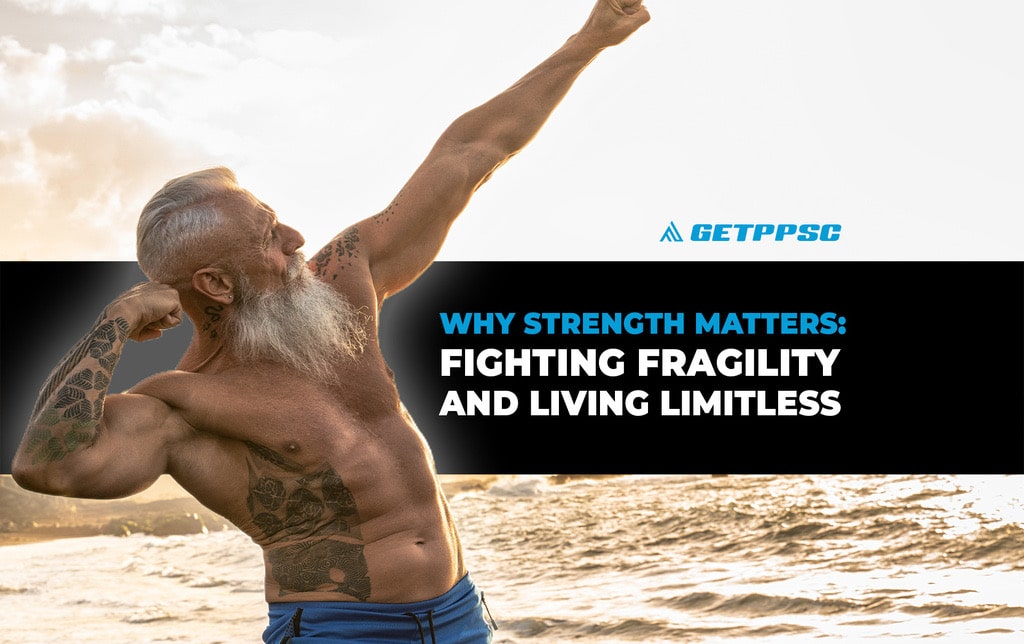We live in a world that is more obese, stressed out, inactive and has a higher rate of chronic disease than EVER before. If you don’t believe me, just look at the statistics that state that 1/3 of our CHILDREN are overweight and at risk for type-2 diabetes! This is insane. We live in a world where it has been normalized for children to get adult diseases. They literally changed the name from “adult-onset diabetes” to just “type-2 diabetes”.

This is a problem.
The sad thing?
We have an opportunity to reverse chronic disease and disability with just one simple metric. It does not come in pill form, it is not the next fad diet and it sure as hell isn’t the 30 day juice cleanse that just popped up on your Instagram feed.
It is one simple thing that a majority of our culture lacks.
STRENGTH!
If you are looking in the dictionary, the ability to produce force or if you are watching the latest Planet Fitness commercial, the ability to pick things up and put them down. Strength does not just have to be chasing a 1RM back squat (although it can be). Practically for most people, strength is the physical characteristic that lets you play with your kids, carry the groceries and go up/down the stairs without needing an ice pack and nap afterwards.
STRENGTH FUCKIN MATTERS!
Regardless of the exact definition, physical strength is the MOST important quality for ALL age groups and has been PROVEN to be a predictor of all-cause mortality in many different populations.(1-3) Currently, there are a ton of metrics to measure health and wellness such as, cardiovascular status, history of smoking, blood markers, etc. I mean shit, you can buy a tracker that will tell you how much you slept and if you are allowed to go hard in the gym today! Yet, none of these compare to strength and strength’s ability to keep you healthy and alive.
Even crazier, our medical system is not set up to allow strength to be the leading intervention. If you go to the doctor what do they typically give you? An injection or a pill.
The rehab professional? A band and ultrasound. If you are really lucky, a severely underloaded and underchallenging program.
The surgeon? Surgery that does not have any guarantee at helping you meet your personal goals.
All of those things may have their place however, none of them do a damn thing for longevity.
Fitness and rehab professionals are literally on the front lines and have the largest opportunity to help shift the health and wellness landscape of this country but yet more and more people wait to act until they get diagnosed with a disease. This is not preventative care, this is sick care. Are you going to wait to patch the hole in your tire until it blows up? I don’t think so. So why do we wait until our bodies break down to address our inadequacy when it comes to health and wellness?

I get it, strength training is HARD work and it is much easier to just pick up the remote to watch the next episode of “The New Girl”. However, until we see a large shift in lifestyle choices with an emphasis on exercise that involves strength training, we will continue to see a population overrun with chronic issues and inability to maintain an independent lifestyle.
FRAILTY, FUN, AND FUNCTION

Reality check – as people get older, they get weaker. The average adult loses strength at a rate of 10% per decade starting at the age of 30. This peaks to 15% per decade after the age of 60.(3) If you think that is bad, power loss is 20-30% loss per decade. These are metrics that are used to describe the “slippery slope of aging” and the importance of functional reserve.
The slippery slope of aging refers to an expected loss in physiological systems of the body that include not only the musculoskeletal system but also the cardiac, respiratory, renal and sensory (vision, hearing) systems. (4) With age comes a risk of downward trajectory through the following categories:
FUN: the physical ability to do whatever one wants for as long as one wants. Think of this as the ability to enjoy life without restriction as being able to perform any physical activity without worry that you can’t. You want to run around in the yard with your grandkids or jump in the front seat of the roller-coaster, arms sky high because “YOLO”? Go right ahead.
FUNCTION: refers to individuals who have to make a choice about their physical activities due to decreased physical capacity. An example of this would be someone who requires an assistive device or a motorized cart in order to leave the house or get around the grocery store. At this stage, you have to think twice about every physical decision because you do not have enough gas in the tank to perform them all.
FRAILTY: This category includes individuals who require assistance to complete basic activities of daily living (cooking, cleaning, bathing, etc). Frailty is a unique category because it has its own clinical criteria which are as follows (Fried et al reference 135):
- Unintentional weight loss of 10lbs or more in the past year
- Muscle weakness (grip strength <23lbs for women; <32lbs for men)
- Walking speed <0.8m/s
- Low level of activity (270 kcal/week for women; 383 kcal/week for men equivalent to sitting quietly and/or lying down for the vast majority of the day).
For this criteria, a person is considered frail if he or she meets 3 out of 5

A person is considered prefrail if he or she meets 1-2 out of the 5.5
This person often does not look “well”, walks extremely slowly and spends most of the day in a chair because they need assistance for every daily activity.
FAILURE: Someone who is completely dependent and often bedbound. Literally, this person is using every energy reserve just to stay alive. Getting out of bed and walking is not an option.
I know for everyone reading, you just thought of a family member, a friend or someone you know who could fit into one of these categories. For those of you who have had to take care of sick friends or family, watching someone lose their independence is extremely hard. It is something I have gone through personally, and I would wish it on no one else.
Everyone has their own goals in life but I know for a fact that as I get older, I want to enjoy the shit out of life and be able to play 18 holes, hike a mountain and pick up my grandkids. I want to die young at an old age. I DO NOT want to be that individual who is unable to get out of the recliner or walk without assistance. If given the choice, I cannot imagine many people would want to lose their independence either. The way to get there is to maximize functional reserve through strength training.
FUNCTIONAL RESERVE

I liken the concept of functional reserve to body armor. Simply stated, functional reserve can be thought of as the amount of armored layers a person has in case of attack. An attack on health can be something like a broken bone that leaves you unable to walk for 8 weeks. It could also be as simple as a cold. The issue- for some people, they have no armor so that common cold leaves them on their deathbed.
Remember when you were 18 and could bounce back from nearly every stupid decision? Having a high level of functional reserve and strength is like that. It is what lets you tweak your back deadlifting on a Thursday and yet still able to train without missing a session.
Simply stated, the more functional reserve (strength) an individual has, the faster and more likely that person will be able to return to their normal level of function.
A good example of this is what just happened to my 85-year old grandfather. He has been active his whole life and into retirement. He plays golf and bowls a few times a week as well as walks and strength trains on the other days. Last year he ended up with pneumonia and some other related health issues that left him in the hospital for a week. Now, in this exact scenario, a individual without any functional reserve would most likely be heading to their passing. My grandfather was fortunate enough to have enough body armor that he was able to return home and back to all of his activities (although it did take many months to get there) and ultimately, into the functional category of life.
This is a very real scenario where one medical event could leave someone who was functioning in the fun category as functioning in the frailty category. This is why strength and functional reserve is so vital! In fact, leg strength has been determined to be the single most important predictor of subsequent hospitalization and is more important than physiological markers or disease.(4) With such high level evidence continuing to demonstrate the life-changing effects of muscular strength we in the fitness and rehab world have a duty to continue to push our clients and patients every single day.
INJURY PREVENTION

Injury prevention in sports is a hot button topic debated about all over the sports medicine and fitness communities. Can we really “prevent” injuries with 100% certainty? Most likely not but what we CAN do is potentially reduce risk with a solid strength base. This has been proven multiple times across different sports. Strength may not be able to help much with a 100MPH fastball nailing you in the wrist, but when it comes to non-contact based injury mechanisms, strength wins. Simply stated, stronger athletes do not get injured as often.
A few years ago, when I was treating in New York City, I had 14 runners all come to me for care all within 12 weeks of the NYC marathon. I distinctly remember two of them having hip labral tears and not even being able to walk without a limp. Now, for anyone who has worked with runners you KNOW that NOT RUNNING is NOT an option. It does not matter the pain and suffering, these individuals were going to at least crawl over the finish line. On their follow-ups 13 of the 14 told me they had set a PR! And of those 13, 100% of them did it with an existing “injury”. Even crazier, every single runner ran LESS and strength trained MORE in those 12 weeks leading up to race day.
How does this happen?
Well, running requires the body to absorb 2.5 times its own weight while on one leg. So for a 135lb runner the body sees 335lbs of load on one leg and repeats for 26.2 miles. Now we also know that running forces can be better absorbed by good running mechanics and by reducing ground contact time which can decrease muscular load by up to 50% but in reality no one except the elite runners are able to give a shit about any of that past the 12 mile mark. Spending more time on strength training and less time on the act of running allowed these individuals to “bulletproof” their bodies for their sport.
Now before people get upset because my sample size was not large enough and this “evidence” I presented is full of confirmation bias, the literature is heavily in support of strength training being an effective modality at combating injuries. We see this in team sport athletes who performed greater than 18 weeks of training before sustaining initial injuries being at a reduced risk for a subsequent injury. (7) It has also been demonstrated that across many different sports, well-developed physical qualities are protective against injury8-11. Whether it be related to hamstring and adductor strains in soccer players, shoulder injuries in baseball players or non-contact ACL injuries (12,13), it does not matter. The literature points out time and time again, strength is protective for any athlete in any sport.
THE UNDERLOADING PROBLEM
One of the worst kept secrets in both the rehabilitation and fitness worlds is that just because you were sweating does NOT mean that the exercise you just performed actually did anything to make you stronger. At some point, to actually get stronger, an individual is going to have to move more load. This is why the overload principle has not changed much since its inception in the 70s. In order to extend the limits of muscle performance one must achieve a minimum threshold of intensity during exercise. The ACSM recommends that an 80% intensity of a 1RM is the optimal loading range to obtain a strength result. Yet, we continue to see people lifting the 2lbs dumbbells in the name of “toning”. If longevity is the goal, then lifting heavy shit needs to be the method to get there. There will obviously be some exceptions to this rule for those individuals who are severely deconditioned to the point that getting in and out of a chair for 8 reps is their 80%. However, for the majority of the clients we see, progressive loading through increasing intensity has to be the goal.
There seems to be a big disconnect between the severe underloading that occurs across the rehab and fitness landscape and what individuals ACTUALLY need to be able to do on a daily basis. For example, one of the most functional things someone can do is go up and down stairs. It almost does not matter where you live, at some point you will encounter the dreaded stairs in your every-day life. Depending on the height of the step, an individual needs to produce up to 1.6 times their own bodyweight in order to ascend. And this is only ONE step. So if you weigh 200lbs your body needs to produce 320lbs of force on ONE LEG in order to go up ONE…..SINGLE….STEP. These forces are even higher on the way down due to the eccentric nature of the movement.(6) And yet, there is a prevalence of bodyweight leg exercises or just straight-up lazy supine straight leg raises all in the name of “strength”. I call bullshit. If we have already established loading parameters for functional exercise demands, why do we continue to waste our clients time with severely underloaded movements?
DIE YOUNG AT AN OLD AGE
Regardless of if you are a 90 year old grandparent, a 25 year old professional athlete or a 40 year old weekend warrior. There is ONE metric that spans across all age groups for health and wellness and that is STRENGTH. There is nothing that is more predictive of how hard you are to kill.
Ultimately, if you want to stay healthy and independent then strength training is the modality that will allow you to die young at an old age, living life like a badass!
REFERENCES
1-Kraschnewski, JL., Sciamanna CN., Poger, JM, et al. Is strength training associated with mortality benefits? A 15year cohort study of US older adults, Preventive Medicine,Volume 87,2016,Pages 121-127, ISSN 0091-7435,
https://doi.org/10.1016/j.ypmed.2016.02.038.
2-Kamada M, Shiroma EJ, Buring JE, Miyachi M, Lee IM. Strength Training and All-Cause, Cardiovascular Disease, and Cancer Mortality in Older Women: A Cohort Study. J Am Heart Assoc. 2017;6(11):e007677. Published 2017 Oct 31. doi:10.1161/JAHA.117.007677
3- Li R, Xia J, Zhang XI, et al. Associations of Muscle Mass and Strength with All-Cause Mortality among US Older Adults. Med Sci Sports Exerc. 2018;50(3):458-467. doi:10.1249/MSS.0000000000001448
4. Avers, D.A., Wong, R. Guccione’s Geriatric Physical Therapy 4th Edition. Mosby; 4th (December 19, 2019). ISBN-13: 978-0323609128
5- Avers, D.A., Wong, R. Guccione’s Geriatric Physical Therapy 4th Edition. Mosby; 4th (December 19, 2019). ISBN-13: 978-0323609128
6- Stacoff A, Diezi C, Luder G, Stüssi E, Kramers-de Quervain IA. Ground reaction forces on stairs: effects of stair inclination and age. Gait Posture. 2005 Jan;21(1):24-38. doi: 10.1016/j.gaitpost.2003.11.003. PMID: 15536031.
7- Gabbett TJ The training—injury prevention paradox: should athletes be training smarter and harder? British Journal of Sports Medicine 2016;50:273-280.
8-Gabbett TJ, Domrow N. Risk factors for injury in sub-elite rugby league players. Am J Sports Med 2005;33:428–34.
9Gastin PB, Meyer D, Huntsman E, et al. Increase in injury risk with low body mass and aerobic-running fitness in elite Australian football. Int J Sports Physiol Perform 2015;10:458–63.
10 53 Gabbett TJ, Ullah S, Finch CF. Identifying risk factors for contact injury in professional rugby league players—application of a Frailty model for recurrent injury. J Sci Med Sport 2012;15:496–504.
11 54 Quarrie KL, Alsop JC, Waller AE, et al. The New Zealand rugby injury and performance project. VI. A prospective cohort study of risk factors for injury in rugby union football. Br J Sports Med 2001;35:157–66.
12- Monajati A, Larumbe-Zabala E, Goss-Sampson M, Naclerio F. The Effectiveness of Injury Prevention Programs to Modify Risk Factors for Non-Contact Anterior Cruciate Ligament and Hamstring Injuries in Uninjured Team Sports Athletes: A Systematic Review. PLoS One. 2016;11(5):e0155272. Published 2016 May 12. doi:10.1371/journal.pone.0155272
13- Bodor, M. (2001), Quadriceps protects the anterior cruciate ligament. J. Orthop. Res., 19: 629-633. https://doi.org/10.1016/S0736-0266(01)00050-X




